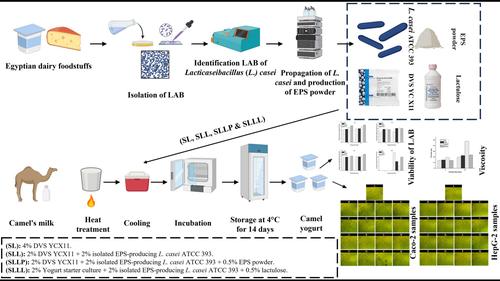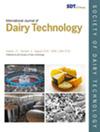利用乳酸菌ATCC 393产生的外多糖生产骆驼奶酸奶及其潜在的抗癌和保肝特性
IF 2.5
2区 农林科学
Q3 FOOD SCIENCE & TECHNOLOGY
引用次数: 0
摘要
使用具有生产外多糖(EPS)能力的益生乳酸菌(LAB)制作驼奶酸奶。在传统酸奶培养物中加入了被确认为最有效的 EPS 生产者的乳酸酶杆菌 ATCC 393。我们比较了添加 L. casei ATCC 393 和 EPS 粉(SLLP)与乳糖的效果。评估包括样品中的酵母菌、霉菌、细胞毒性和 IC50 值。结果表明,在 SLLP 中,细菌计数、酵母菌活力、粘度、抗增殖效果均有所提高,且 IC50 值较低,这表明生产 EPS 的 L. casei ATCC 393 及其衍生 EPS 有可能应用于功能食品的开发。本文章由计算机程序翻译,如有差异,请以英文原文为准。

Utilisation of Lacticaseibacillus casei ATCC 393-derived exopolysaccharide for camel milk yoghurt production and its potential anticancer and hepatoprotective properties
Camel milk yoghurts were created using probiotic lactic acid bacteria (LAB) with exopolysaccharide (EPS) production capabilities. Lacticaseibacillus casei ATCC 393, identified as the most efficient EPS producer, was incorporated into conventional yoghurt culture. We compared the effects of adding L. casei ATCC 393 with EPS powder (SLLP) against lactulose. Evaluations included LAB, yeast, mould, cytotoxicity and IC50 values in the samples. The results demonstrated increased bacterial counts, LAB viability, viscosity, antiproliferative effects and a lower IC50 in SLLP, indicating the potential application of EPS-producing L. casei ATCC 393 and its derived EPS in the development of functional foods.
求助全文
通过发布文献求助,成功后即可免费获取论文全文。
去求助
来源期刊
CiteScore
7.00
自引率
4.50%
发文量
76
审稿时长
12 months
期刊介绍:
The International Journal of Dairy Technology ranks highly among the leading dairy journals published worldwide, and is the flagship of the Society. As indicated in its title, the journal is international in scope.
Published quarterly, International Journal of Dairy Technology contains original papers and review articles covering topics that are at the interface between fundamental dairy research and the practical technological challenges facing the modern dairy industry worldwide. Topics addressed span the full range of dairy technologies, the production of diverse dairy products across the world and the development of dairy ingredients for food applications.

 求助内容:
求助内容: 应助结果提醒方式:
应助结果提醒方式:


